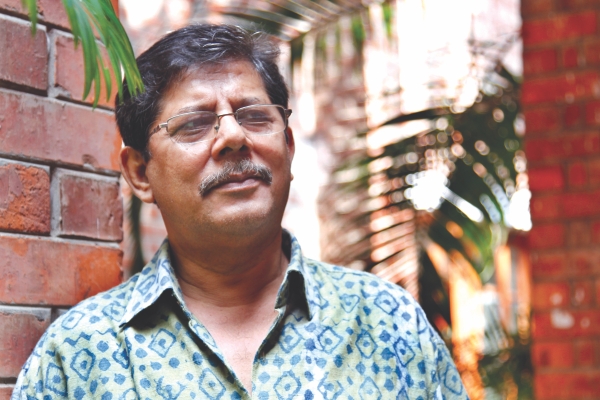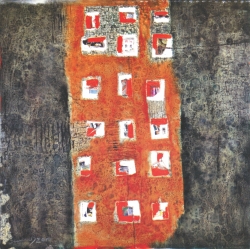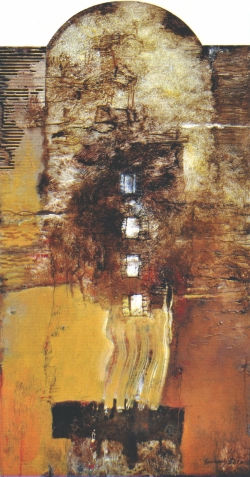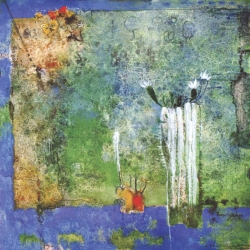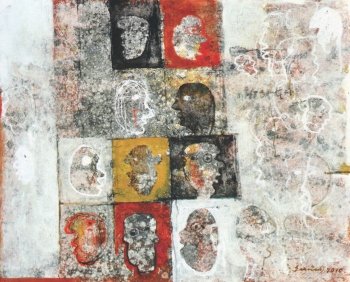| Home - Back Issues - The Team - Contact Us |
 |
| Volume 10 |Issue 41 | October 28, 2011 | |
|
|
Profile
Evidence of our times– Fayza Haq Despite living in Japan for a long time in pursuit of higher studies, Mohammad Eunus has not been directly influenced by the tender beauty of Japanese art. His colours clearly voice the existential dilemma of our times. However, his views are not only destructive: they incorporate hope and search for beauty. He documents the discontent and fear of our times in his abstracts. The images that Eunus has created by burning acrylic sheets are evidence of the decaying world. The abstract expression of this artist is different from other contemporary artists. Instead of using pleasing colours of the others' work, he bears witness to the madness of the current times in an eruption of violent colours in different layers. His recent solo exhibition at Bengal Gallery is an explosion of colour accompanied by contrast and done in semi abstract. “ I used to do a lot of realistic work during my student days and my Zainul Abedin award was for such a work" says Eunus. "Today there is a lot of minimalism in my work but if you look deeply you will find forms but treating the composition you will find the work post-modern. I feel that realistic work is bound within limitations and you cannot stretch your imagination very much in that.”
The new work in the 'Evidence' series dwells on the Liberation War. In one of the paintings you see a splash of green; there are two forms next to it that stand for a male figure and that of a female and here the artist has brought in the subject of rape. Below is burnt brown, which to him, is the colour of burnt and dried blood. On top, a plastic corrugated sheet represents how the truth has been suppressed. Thus we see burnt holes in the plastic sheet and the truth gaping through it. The second painting has brought in the image of a horse - a symbol of power of the common people. It has been depicted as burnt but still holding up its head. Below is the burnt ground with a few corpses. In another painting we see a fragment of the sea and oblong gelatinous shapes in gray, white and black seen on blue. In another composition is an old wall with lichens shown in shades of brown, black and gray. Within it is a triangle form that brought in human vision. “The wall is a witness to the truth although it cannot say anything", says the artist. "There is a hope in the old wall that one day it will be something beautiful and bright. The wall is a symbol of the oppressed that no one bothers about but that continues to exist.”
The painting which reaches out to the beginning of civilisation has brought in a horn and a bison. Another brings simplified forms of human beings done with child-like simplicity on a background of brown, beige and white. In yet another is the “Watcher” with the human form with an enlarged eye while another brings in the atmosphere of the orchestra with the keys of the piano at the bottom. The abstract splashes on top with burnt sienna, beige and blue brought in the atmosphere of a grand musical evening. Female figures in green and yellow have merged into one another in the next canvas. Eunus has won eleven awards and grants including the Third Prize at the First Islamic Art Biennal, Tehran, Iran in 2001, Sho Rei Award, Tokyo, Japan in 1986, and the Grand Prize for Oil Painting, at the Institute of Fine Arts, DU, 1977. He has had over 25 major group exhibtions and over 20 solo exhibits at Japan, USA and Bangladesh. Later, sitting at the café of Bengal Gallery, over a bowl of chicken curry and a plate of nans, Eunus, a professor of the Institute of Fine Arts, DU, reveals a jovial side. When asked about the how important it is to get one's work sold or win awards, he remarks lightheartedly: "I work for my own satisfaction and not for public approval. I work with my mind, heart and soul, and don't much worry about remunerations. The works get sold off, even before they are displayed. I don't even have to be a party-goer to please patrons. My paintings are picked by patrons from my house. I don't fancy ' addas'. I keep to myself and my studio at Uttara. I paint as the mood takes me, without being disturbed by idle chatter.” Eunus says that he is a full time studio artist and works in his studio everyday. He says: "I believe in self –satisfaction. If the work gets awards and accolades: Well and good." He talked about on what his teachers in Tokyo taught him, that was vital for his painting. In Dhaka, as a BFA student Eunus studied graphic arts. "I wanted to branch out to modern, abstract painting, while in Dhaka, inspired and guided by Mohammed Kibria, who used to visit his students in the College hostel" say Eunus. "While in Japan I changed to oil painting. Earlier on too, I was more involved in painting rather than graphics. Even in the third year, while in Dhaka, I got the Painting Awards, before going to Japan. This is because doing a book cover or doing its illustrations did not give as much satisfaction as in painting. Miazaki Susumio, a renowned pioneer in painting like Mohammed Kibria. I was in Tama University, doing two years in painting and six months in mastering the language. There was a wonderful rapport between his students and himself. I wanted to go out, so to say, of what I just saw, to go beyond what I seem, and give vent to my inner feelings. Abstraction alone can blend in my feelings and imagination, along with my hopes. Anger and anxiousness can also be expressed in semi-abstraction. This was useful for me in teaching my students in Dhaka, when I'd returned. My teachers, such as Qayyum Chowdhury, Samarjit Rai Chowdhury were my department teachers, who had helped me no end, earlier on, as a student residing in hostels. In abstraction, I'm finally influenced by Anthony Klab, and Anthony Tapis—both being Spanish.” Giving the reason for his fascination, he says, seeing the lines, textures of his work, his Japanese teacher egged him on to the works of these Spanish masters, specimens of which were there in the Tokyo Museum.
Entering the world of art was not an easy move for Eunus whose father had always wanted him to study medicine. He even prepared a chamber in which Eunus could do his medical work. Eunus says that he came to the Art College in 1972 and was one of the first batches of the institute. He had just come back from the Liberation War. By then his father had given his consent to him being an artist. Speaking about the sources of inspiration, he says that he looked to the master painters in the west, as did all the painters in the Art College. Eunus says that just as Picasso didn't become the painter of “Guernico” in a day, so the Bangladeshis had their Liberation War to motivate them. He mentions Quamrun Hasan who made the famous "Kill the monster" poster, of Yayha Khan, the drunken general who led the genocide of the Bengali people. Apart from Shahabuddin, no other artist has gone on dwelling on the subject in a big way.” Eunus mentions leading icons he has always admired and who have passed away -Mohammed Kibria, Aminul Islam, and Maqbool Fida Husain—a great Muslim contributor to art in the Subcontinent—whom his own mother country failed to honour in way that was befitting. As a painter in his own nook in Uttara, he is greatly influenced, by these three giants, if not directly, but otherwise, says Eunus.
Copyright
(R) thedailystar.net 2011 |
